Myths vs Reality. #2 Christmas. #1 The brain basics. A. Metaphorical brain
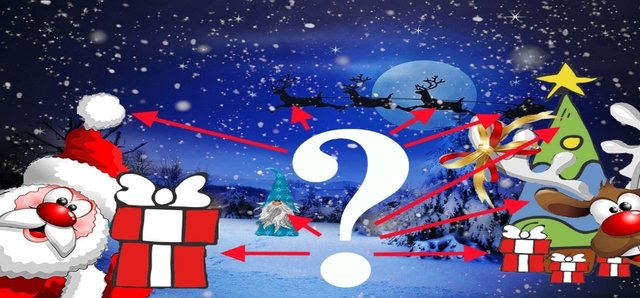
(the overall image was created by me by combining the images from Pixabay, namely: Flying reindeers, Santa and a reindeer, An Elf, Christmas attributes)
As mentioned in the previous post (by the way, pay attention to the Disclaimer provided there), the purpose of this series is not just trying to provide scientific explanation for the stuff related to Christmas, but (and this is even more important) to answer the question
Why have/How could we ended up in such a situation (having flying reindeers and Santa Claus, decorating Christmas trees and giving presents each other etc.)?
What brain’s characteristics/features enforced that to happen?
It was mentioned that an important role in Christmas-related stuff explanation is played by metaphors.
Metaphors are a part of the way we think.
I’d say that metaphorical way of thinking is deeply hardwired into our brain.
the view on metaphor has been transformed from it being something poetic reserved for literary use, to something fundamental and generalizable in our daily language and thinking (Lakoff and Johnson, 2003). The pervasiveness of metaphors has been quantified: People use about 5 metaphors for every 100 words of text (Pollio et al., 1990), including 1.8 novel and 4.08 frozen metaphors (e.g., leg of a table) per minute of discourse (Pollio et al., 1977).
(source - [1])
-> People use about 5 metaphors for every 100 words of text
Metaphor is incredibly pervasive in everyday discourse. By some estimates, English speakers produce one unique metaphor for every 25 words that they utter [37].
(source - [3])
It’s a metaphor (represented/described as images) which helps us to understand and remember things better (for more information on why it is so see the next part; one of the reasons is that, according to some theories, the thinking itself happens with the help of images (2D/3D)) [2].
For example (to my knowledge), tokens like Steem, XRP are quite often represented as coins (the ones that some of us hold in their pockets), but they are just numbers in the code hosted somewhere on the servers (correct me if I’m wrong). The coin idea helps non-developers to grasp the concept of tokens/coins.
Definitions
Let’s take a look at the definitions for some terms related to metaphors:
metaphor
If one thing is a metaphor for another, it is intended or regarded as a symbol of it.
[Collins Cobuild Advanced Learner’s English Dictionary. New Digital Edition, 2008]
personification
the attribution of a personal nature or human characteristics to something non-human, or the representation of an abstract quality in human form
[Oxford Dictionary of English, 3rd Edition, 2010]
allegory
Allegory is the use of characters and events in a story, poem, or painting to represent other things.
[Collins Cobuild Advanced Learner’s English Dictionary. New Digital Edition, 2008]
What’s the pattern?
All of them help us to create a symbolic/iconic representation/images of objects/properties (either abstract or concrete).
Abstract and concrete are classifications that denote whether the object that a term describes has physical referents. Abstract objects have no physical referents, whereas concrete objects do.
(source - Wiki)
For example,
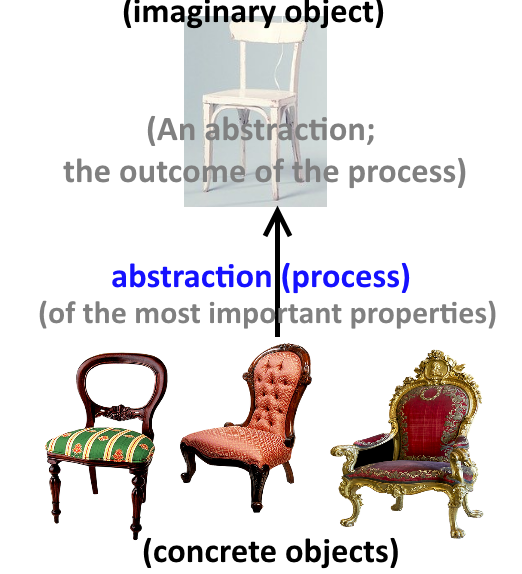
(The overall image above was created by me. Chairs images were taken from Pixabay here,here and here)
There’re plenty of chairs on the Earth. You, probably, have seen dozens of chairs in your lifetime. They had different shape, colour etc. But all of them have something in common as well (4 legs (usually), square flat sitting, chair back etc.). You can see the concrete objects on the bottom of the image and an abstraction (the chair which has all the most important properties of the chairs) on the top of it.
Abstraction
The process which helps us to create a generalized picture/image/representation (and the result of it) is called abstraction.
Abstraction in its main sense is a conceptual process where general rules and concepts are derived from the usage and classification of specific examples, literal ("real" or "concrete") signifiers, first principles, or other methods.
"An abstraction" is the outcome of this process—a concept that acts as a common noun for all subordinate concepts, and connects any related concepts as a group, field, or category.[1]
(source - Wiki)
And it is the abstraction (the process) which helps us to create metaphors, personifications and allegories.
|| Advanced reader information
The problem of concrete and abstract (the problem of universals) goes back to Ancient philosophical schools (Plato etc.)
In philosophy and its sub-branch metaphysics, the problem of universals refers to the question of whether properties exist, and if so, what they are.[1]
Properties are qualities or relations that two or more entities have in common.
(source - Wiki)
For example, it’s the combination of 4 legs, square flat sitting, chair back what the chairs on the image above have in common. And it’s them what help us to abstract from concrete objects (the chairs we’ve seen in our lifetime) and create a generalized/an abstract one.
As a result, we have sort of a pattern which helps us to distinguish chairs from, let’s say, tables and cabinets.
Let me provide you one more example (biological example).
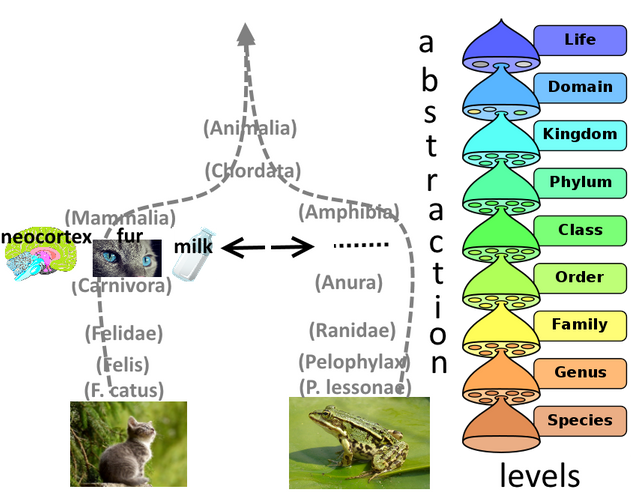
(The overall image was created by me. The taxonomy image was taken from Wiki (Public domain), the milk image was taken from Pixabay, just like the fur, neocortext, kitten and frog)
As you probably know, there’s a hierarchy of taxonomic ranks used in biology like genus, family, order, class etc. (for more info read taxonomy).
We abstracted the most important properties of the group of animals. You can see on the image above that it's the neocortex, fur and an ability to produce milk (among some other characteristics) which help us to distinguish mammals from, let's say, amphibia on the class level.
If you think about it, it’s only individuals of the species which exist. All those cool terms (genus, family etc.) were created by us (humans) so that we could easily navigate in the world of life forms and better understand each other.
The terms allow us to build classification of life forms.
(Fore more information go to Tree of life (biology))
And one more example

(Photo by Caspar Camille Rubin on Unsplash)
You (as a consumer of the product, not developer/programmer) don’t need to know programming languages and to be an engineer to use the device, right? You, most likely, don’t know what happens on the programming or physical level when you press the buttons of the device. You were provided with the buttons/sensor level of abstraction which allow you to use the device.
Once we have images/representations, we can create a story (and allegory) with the help of the images/icons/symbolic representations. And the advantage of them is that
Stories up to 22 times more memorable than facts alone
Jennifer Aaker (Professor of Marketing at Stanford Graduate School of Business)
Multiconstraint theory of analogy/metaphor (by Holyoak and Thagard)
There’s also an analogy.
And analogy is
a comparison between one thing and another, typically for the purpose of explanation or clarification
[Oxford Dictionary of English, 3rd Edition. Oxford University Press, 2010]
An analogy is something similar to the metaphor.
As far as I understand, the difference is that
The short answer is that a metaphor is one kind of analogy.
(StackExchange)
In 1995 Holyoak and Thagard developed a theory which tries to explain the way analogies work on the psychological/psycho-physiological level (for more info you can read the paper called “The Brain is Wider than the Sky: Analogy, Emotion, and Allegory”).
I would want to deal in this series with metaphors.
Given that metaphor is a sort of sub-type of analogy, I’ll apply the same theory (developed by Holyoak and Thagard) to metaphors.
Aside from the definition for analogy provide above, it can be defined the following way
Analogies are systematic comparisons in which a source situation provides information about a target situation.
In allegories, the source is the literary work created by the writer and the target is some aspect of the human condition;
(source - [4])
So, it’s about finding correspondences between source and target situations.
Metaphors require people to create a mapping between the source and the target, so that we could find out what aspects of the source correspond to what aspects of the target.
For example, "Animal Farm" by George Orwell (1945).
In a nutshell, it provides an allegory for the development of communism in the Soviet Union where
Russia -> the farm
the humans on the farm -> aristocrats of Russia prior to the revolution
the pigs -> the communist revolutionaries
the dogs -> the secret police
Napoleon -> Stalin
etc.
That mapping is a tough task and
Psychological evidence and computer models suggest that our minds handle this complexity thanks to three constraints that help to direct analogical mapping: similarity, structure, and purpose. These constraints work together to ensure that the properties and relations in a source domain can usefully be transferred over to a target domain.
(source - [4])
So, let’s say that we do mapping with the help of kind of filter. And those 3 constraints help us to adjust the filter, so that we could successfully choose among all the properties/relations the ones we need and transfer them from the source to the target.
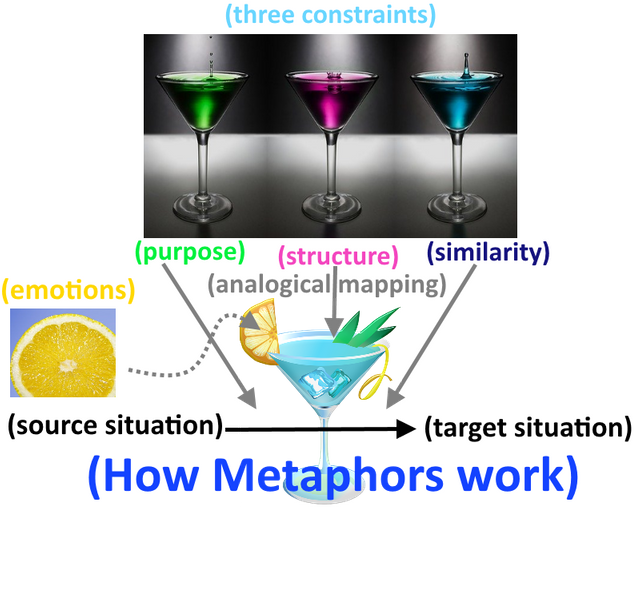
(The overall image was created by me. Cocktails images were taken from Pixabay (here and here), lemon was taken from Pixabay as well)
You can think of the image above (which itself is a metaphor for the 3 constraints) as a receipt on how to create a great/powerful metaphor, so that people could easily map the source situation with the target one.
Note the lemon piece. It represents emotions. We’ll talk about them later in the post.
It’s going to be easier to explain all this with examples.
Here’s my own 2 examples
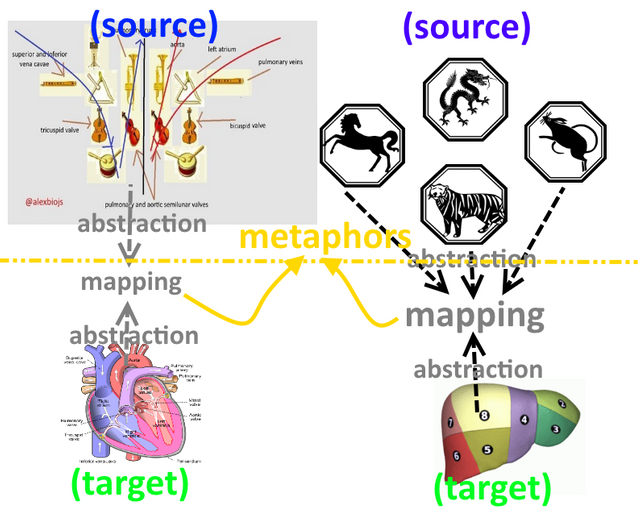
(The overall image was created by me. The heart and liver images were taken from Wiki (here (CC BY-SA 3.0) (no changes were made) and here (CC BY-SA 2.1 JP (no changes were made). See the links below for the sources of the rest of the images)
(for more information on what is this, you can visit this post (Mnemonics experiments. #1 “Superpower” of the Liver. Inspired by Jackie Chan’s work) and this one (Mnemonics experiments. #2 The heart orchestra evolution (literally). + The human heart song))
In this case the sources are different orchestra arrangements and the signs of of the Chinese zodiac.
The targets are the heart systems of different groups of animals and liver functions.
The 1st constraint is similarity (in terms of meaning or appearance).
Well, even though this one is the most obvious, I suppose this is where my examples fail to be great metaphors (there’s some similarity between heat and orchestra, but there’s no much of it between talismans from the Jackie Chan Adventures and functions of the liver. I suppose it’s because the latter are likely abstract notions as opposed to the heart and orchestra).
The 2nd constraint (structure) is more complex. It’s about carrying systematic relationships from the source to the target.
However, that’s where I guess my example with the heart/orchestra metaphor succeeded: heart and orchestra are systems composed of a number of elements (have the same relational structure), each of which perform a certain function.
The 3rd one is a purpose.
Purpose concerns the cognitive function that the allegory is supposed to accomplish. In religious allegories, for instance, the primary function is inspirational and pedagogical, using an imagined example to teach people how to live.
An additional purpose of an allegory may be entertainment, amusing people to see correspondences between an imagined world and the real one.
(source - [4])
I suppose the purpose of my metaphors provided above is -> educational.
Emotions.
Now for the emotions (lemon piece added on that cocktail image above).
According to Wiki
Emotions are biological states associated with the nervous system brought on by neurophysiological changes variously associated with thoughts, feelings, behavioural responses, and a degree of pleasure or displeasure.
(source)
There’re 3 theories (at least) of emotions.
1/ appraisal theory which postulates that emotions are
judgments that evaluate a situation with respect to how well it accomplishes goals
(source - [4])
2/ physiological theory which postulates that emotions are
reactions to changes in bodily states such as heart rate and breathing patterns.
(source - [4])
3/ It’s a combination of the 2 above.
From this perspective, the emotions generated by allegories and other analogies are the result both of judgments that the reader makes about the allegorical source along with its real-life target and of physiological responses that result from reading or hearing the allegorical work
(source - [4])
For the allegory/metaphors to work, they need to have some sort of affective/emotional dimensions.
As for my own examples, I can say that the talismans from the Jackie Chan Adventures generate positive emotions in me because the animals produced with the help of the talismans defend people on the Earth from the demons and other evil creatures.
Maybe, you could tell as well?
As for affective dimensions, I’d like to present another example
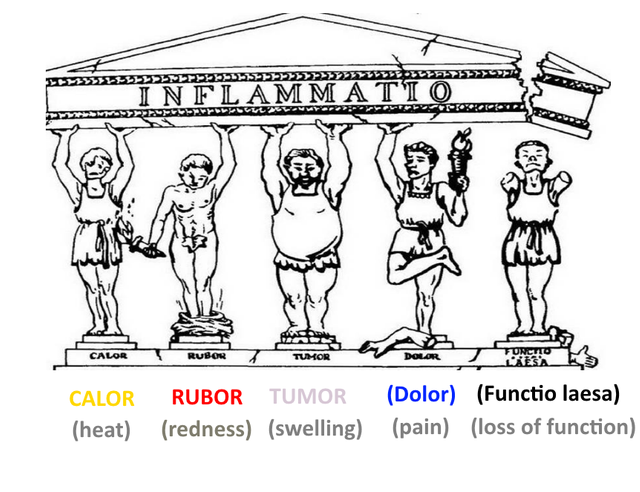
(source. Сaptions were added by me)
With the help of abstraction we can abstract the most important signs of inflammation, namely: Dolor (pain), Calor (heat), Rubor (redness), Tumor (swelling), Functio laesa (loss of function) [5].
And then we encode them into statues. Note that each statue corresponds to a particular sign of inflammation. You can see the torch heating the 1st statute (hence, -> calor (heat)), naked statute (the second one) which corresponds to rubor (redness) etc.
The first time I saw the image in a biochemical textbook in 2013. And since that time I can always decode/remember all the 5 signs of the inflammation. I believe it is so because the procedure of encoding/decoding information this way (with the help of the images) corresponds to the very nature of the thinking (for more information on this see the next post) and they generate very powerful emotions.
The affective dimensions can be displayed with the help of **cognitive-affective diagrams **
originally developed for analyzing political disputes (Findlay & Thagard, in press).
Concept diagrams have been used for decades to analyze the structure of complex representations, but cognitive-affective diagrams add an additional dimension by indicating the emotional significance of the key concepts.
(source - [4])
-> add additional dimension by indicating the emotional significance
For example, the cognitive-affective diagram for the Animal Farm might look like
In one of the next posts we’ll try to create cognitive-affective diagrams for the metaphors/allegory trying to provide scientific explanation for the Christmas-related stuff.
If you are curious on what parts of the brain are responsible for the emotions, then it’s in the realm of the limbic system (especially amygdala).
Shown in research to perform a primary role in the processing of memory, decision-making and emotional responses (including fear, anxiety, and aggression)
(amygdala)
To summarize,
In sum, the mental processes by which a reader represents, understands, and learns allegorically … depend on brain mechanisms for encoding information and using it to produce analogical inferences and emotional reactions.
(source - [4])
Behaviour changes
There’s a great book called “Thinking, Fast and Slow” (by Daniel Kahneman; 2011).
It tells about the thinking process which happens with the help of 2 systems in our brain/mind. The first one is more a subject to biases that the second one. And one of those biases is called priming effect. If a person is presented with something particular, then sometimes that something might have impact on the choice the person will do/on the person’s behaviour.
I remember one example. Some people taking part in the experiment were told some words related to the old age, while the rest were not. Then the both group of people moved from one room to another, and it turned out that the people of the first group were moving slower that the people of the latter one.
I mentioned this example to stress the power of a written/spoken words. They can change our behaviour drastically (which happens sometimes unconsciously/unknowingly for us).
And metaphors can change our behaviour as well. Remember the 3rd constraint (purpose)?
Metaphors can change the way we reason about some problems [3].
metaphors exert an influence over people's reasoning by instantiating frame-consistent knowledge structures, and inviting structurally-consistent inferences.
(source - [3])
-> drastic influence
We find that exposure to even a single metaphor can induce substantial differences in opinion about how to solve social problems: differences that are larger, for example, than pre-existing differences in opinion between Democrats and Republicans.
(source - [3])
-> larger, for example, than pre-existing differences in opinion between Democrats and Republicans.
people chose information that was likely to confirm and elaborate the bias suggested by the metaphor
Our results suggest that even fleeting and seemingly unnoticed metaphors in natural language can instantiate complex knowledge structures and influence people's reasoning
(source - [3])
Metaphors are
a fundamental part of the language system.
The metaphors in our linguistic system may be offering a unique window onto how we construct knowledge and reason about complex issues.
(source - [3])
I quoted all that to stress the importance of metaphors in our life.
They are a part of the way we think and they have a great impact on how we make decisions/our behaviour.
Now you can only imagine what impact do films, memes, advertisements etc. have on our society by influencing us ether directly or even indirectly (subconsciously).
So, what if Christmas-related stuff is just a bunch of metaphors which constitute a narrative/allegory for the explanation/interpretation of some natural phenomena / social practices/rites?
We’ll try to find out in the upcoming posts.
How many metaphors have I used in the post?
Does it correspond to the
People use about 5 metaphors for every 100 words of text
(source - [1])
rate?
References
All images (without the license specified + those from the film)/videos are used under the doctrine known in USA as "Fair Use" (similar doctrines are used in other countries). For more information visit the US Gov website
Other posts of this series:
Myths vs Reality. #2 Christmas. Introduction
Myths vs. Reality. #1 Vampires, Werewolves… Is there any scientific explanation?
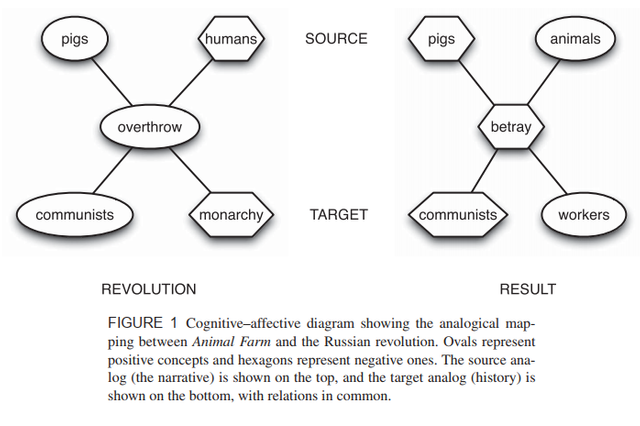
Congratulations! Your post has been selected as a daily Steemit truffle! It is listed on rank 7 of all contributions awarded today. You can find the TOP DAILY TRUFFLE PICKS HERE.
I upvoted your contribution because to my mind your post is at least 3 SBD worth and should receive 186 votes. It's now up to the lovely Steemit community to make this come true.
I am
TrufflePig, an Artificial Intelligence Bot that helps minnows and content curators using Machine Learning. If you are curious how I select content, you can find an explanation here!Have a nice day and sincerely yours,

TrufflePigAccording to the Bible, Graven Images: Should You Worship These According to the Bible?
Watch the Video below to know the Answer...
(Sorry for sending this comment. We are not looking for our self profit, our intentions is to preach the words of God in any means possible.)
Comment what you understand of our Youtube Video to receive our full votes. We have 30,000 #SteemPower. It's our little way to Thank you, our beloved friend.
Check our Discord Chat
Join our Official Community: https://steemit.com/created/hive-182074